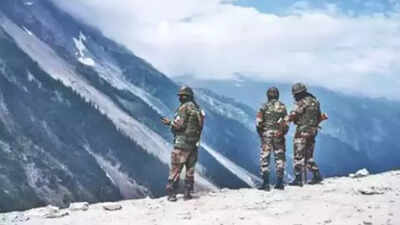Top Searches
- News
- India News
- Benchmark for normalisation in Ladakh would be restoration of status quo ante: IAF chief tells China
Benchmark for normalisation in Ladakh would be restoration of status quo ante: IAF chief tells China

NEW DELHI: Rejecting China’s recent claim that the border situation is now returning to a “normalised” state, IAF chief Air Chief Marshal V R Chaudhari on Tuesday said Beijing should first withdraw troops from all friction areas in eastern Ladakh and restore status quo ante along the Line of Actual Control.
The IAF is maintaining high operational readiness, with additional deployment of radars and assets in eastern Ladakh, as well as closely monitoring air violations and activities by the People’s Liberation Army-Air Force (PLAAF) along the 3,488-km LAC stretching till Arunachal Pradesh.
“We have taken appropriate non-escalatory air defence measures. We have been able to signal our intent and operational readiness through our actions,” said ACM Chaudhari, speaking in the run-up to IAF’s 90th anniversary on October 8.
After the troop disengagement at Patrolling Point-15 in the larger Gogra-Hot Springs area in eastern Ladakh, Chinese ambassador Sun Weidong last week asserted that “the phase of emergency response since the Galwan Valley incident (in June 2020) has basically come to an end”, and the border situation is “now switching to normalised management and control”.
Asked about this, the IAF chief said, “The best benchmark for the situation to return to normal in eastern Ladakh would be to restore status quo ante and complete disengagement at all friction points.”
Army chief General Manoj Pande also recently asserted that two more friction points – the crucially-located Depsang Plains and Demchok -- remained to be defused for overall de-escalation to take place. The two countries still have over 50,000 troops each forward deployed with heavy weapon systems along the eastern Ladakh frontier.
“Recent events on the global landscape have clearly indicated the presence of a strong military is imperative to ward off external threats through deterrence and if deterrence fails, to neutralise those threats,” ACM Chaudhari said.
“Therefore, the armed forces in general, and the IAF in particular, will continue to remain a lynchpin in the national security matrix both as a coercive deterrent as well as a war-winning instrument,” he added.
The IAF has been preparing for all kinds of security challenges, including the “worst-case scenario” of a two-front conflict or an intense and protracted conflict. “Our overall preparation and readiness is a continuous ongoing effort irrespective of any belligerence from China,” the IAF chief said.
The IAF is currently using the Army’s hotline to communicate with China in case of any airspace violation to prevent any inadvertent escalation. This came in the backdrop of Chinese fighters in mid-June stepping up their flying close to the LAC, often violating the 10-km no-fly zone confidence-building measure, as was earlier reported by TOI.
There were at least two confirmed incidents of Chinese fighters even flying over the troop stand-off sites in eastern Ladakh, which led IAF to scramble its own fighters and activate other air defence measures.
China has assiduously used the 29-month long military confrontation in eastern Ladakh to upgrade all its major air bases facing India like Hotan, Kashgar, Gargunsa and Shigatse, with extended runways, hardened shelters and fuel storage facilities for additional fighters, bombers and reconnaissance aircraft.
The IAF is maintaining high operational readiness, with additional deployment of radars and assets in eastern Ladakh, as well as closely monitoring air violations and activities by the People’s Liberation Army-Air Force (PLAAF) along the 3,488-km LAC stretching till Arunachal Pradesh.
“We have taken appropriate non-escalatory air defence measures. We have been able to signal our intent and operational readiness through our actions,” said ACM Chaudhari, speaking in the run-up to IAF’s 90th anniversary on October 8.
After the troop disengagement at Patrolling Point-15 in the larger Gogra-Hot Springs area in eastern Ladakh, Chinese ambassador Sun Weidong last week asserted that “the phase of emergency response since the Galwan Valley incident (in June 2020) has basically come to an end”, and the border situation is “now switching to normalised management and control”.
Asked about this, the IAF chief said, “The best benchmark for the situation to return to normal in eastern Ladakh would be to restore status quo ante and complete disengagement at all friction points.”
Army chief General Manoj Pande also recently asserted that two more friction points – the crucially-located Depsang Plains and Demchok -- remained to be defused for overall de-escalation to take place. The two countries still have over 50,000 troops each forward deployed with heavy weapon systems along the eastern Ladakh frontier.
“Recent events on the global landscape have clearly indicated the presence of a strong military is imperative to ward off external threats through deterrence and if deterrence fails, to neutralise those threats,” ACM Chaudhari said.
“Therefore, the armed forces in general, and the IAF in particular, will continue to remain a lynchpin in the national security matrix both as a coercive deterrent as well as a war-winning instrument,” he added.
The IAF has been preparing for all kinds of security challenges, including the “worst-case scenario” of a two-front conflict or an intense and protracted conflict. “Our overall preparation and readiness is a continuous ongoing effort irrespective of any belligerence from China,” the IAF chief said.
The IAF is currently using the Army’s hotline to communicate with China in case of any airspace violation to prevent any inadvertent escalation. This came in the backdrop of Chinese fighters in mid-June stepping up their flying close to the LAC, often violating the 10-km no-fly zone confidence-building measure, as was earlier reported by TOI.
There were at least two confirmed incidents of Chinese fighters even flying over the troop stand-off sites in eastern Ladakh, which led IAF to scramble its own fighters and activate other air defence measures.
China has assiduously used the 29-month long military confrontation in eastern Ladakh to upgrade all its major air bases facing India like Hotan, Kashgar, Gargunsa and Shigatse, with extended runways, hardened shelters and fuel storage facilities for additional fighters, bombers and reconnaissance aircraft.
FOLLOW US ON SOCIAL MEDIA
FacebookTwitterInstagramKOO APPYOUTUBE
Start a Conversation
end of article









